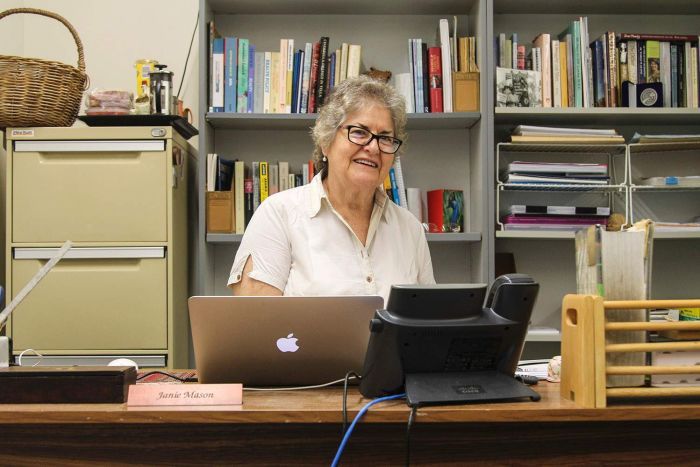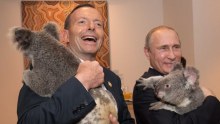Darwin Nursing Museum celebrates 30 years of 'colonising' university spaces with history
Posted
 Photo:
Janie Mason rummaging through the storage room for Darwin's Nursing Museum. (ABC Radio Darwin: Emilia Terzon)
Photo:
Janie Mason rummaging through the storage room for Darwin's Nursing Museum. (ABC Radio Darwin: Emilia Terzon)
Spread across mismatching cabinets, hidden down hallways, and occasionally obscured by errant furniture, the Darwin Nursing Museum is very much an example of history that just crept into the building.
"We've never solicited a single artefact," curator and retired nurse Janie Mason said.
It all started in 1987 with a set of antique bedpans.
Janie was completing a fellowship at Charles Darwin University when she decided to fill an empty nook of her academic wing with something honouring her profession's "unique" contribution to the Northern Territory.
"I asked a man in town for something to fill these empty shelves. Well, he found the bedpans and I paid for them and put them in a cabinet," she said.
"Suddenly people were approaching us about donating stuff they had left over in the wards.
"It was the era of the changeover from metal, glass and rubber medical equipment to plastic and throwaway stuff. So a lot of wards and clinical hospitals and bush clinics had all this stuff to throw out.
"At one stage we ended up with several boxes and crates of just syringes and needles."
Thirty years later the museum has amassed boxes of human bones, pamphlets about bush clinics in the APY lands, replica WWI uniforms with red capes, and numerous examples of "the infamous sputum mug" once used by patients to cough up phlegm and spit.
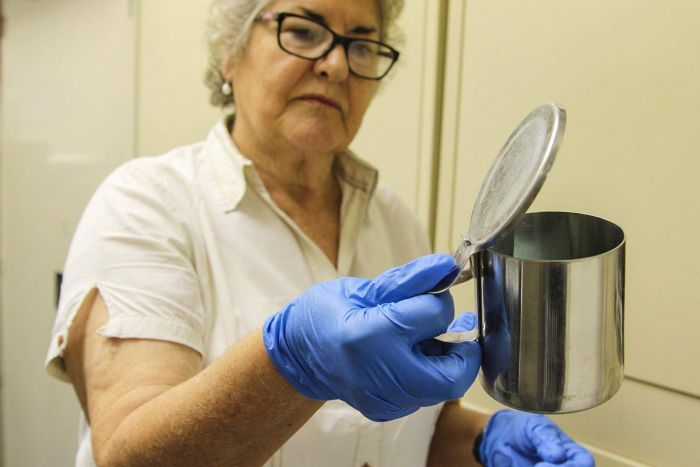 Photo:
Janie holding a "dreaded sputum mug" that nurses had to clean every morning in years gone by. (ABC Radio Darwin: Emilia Terzon)
Photo:
Janie holding a "dreaded sputum mug" that nurses had to clean every morning in years gone by. (ABC Radio Darwin: Emilia Terzon)
But the collection's real numbers is in its faded photographs and documents, many which recall almost forgotten days of mission clinics or kerosene vats that doubled as doona washers.
 Photo:
Photos donated to the museum showing old bush clinics in the Territory. (ABC Radio Darwin: Emilia Terzon)
Photo:
Photos donated to the museum showing old bush clinics in the Territory. (ABC Radio Darwin: Emilia Terzon)
Sorting through this tide of documentation is made possible by a passionate team of stalwarts who come together every Thursday morning in a small office in Charles Darwin University's school of nursing and medicine.
All retired Top End nurses, core volunteers Jacqueline O'Brien, Jenny Hanley and Sue Green have been with the museum since the 1990s and have about a century of professional knowledge between them.
Every Thursday starts with a cup of coffee and gossip.
"It's our first order of business," Sue said.
 Photo:
The volunteers start every Thursday with "their first order of business". (ABC Radio Darwin: Emilia Terzon)
Photo:
The volunteers start every Thursday with "their first order of business". (ABC Radio Darwin: Emilia Terzon)
Gathered around a table in the tea room, Janie and her volunteers discuss the latest happenings and remember days 50 years ago when Darwin's hospital wards segregated Indigenous and non-Indigenous patients.
"It was called the native ward. We'd often have two babies in one cot. You did the births in the ward next to everybody else," Jacqui remembered.
"And we used to take the children, from the ones that could walk, to ones needed to be carried, down to Mindil Beach.
"We'd take their tablets and some water. They'd play there, have fun in the sand, probably a bit of a swim, then bring them back to the hospital sopping wet yet much more contented."
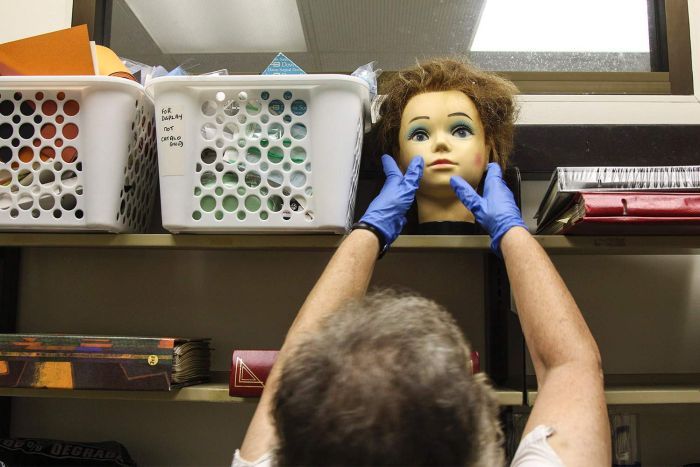 Photo:
The museum's storage room is heaving with different curious items. (ABC Radio Darwin: Emilia Terzon)
Photo:
The museum's storage room is heaving with different curious items. (ABC Radio Darwin: Emilia Terzon)
A woman of ferocious memory, Jacqui is "incapable" of using the computers central to the growing need for collection digitisation, however is irreplaceable for her knowledge of Territory nursing history.
"She can just look at a photo and tell us who is in it. She just comes up with these gems all the time," Sue said.
With Sue and Jenny currently focused on digitising the museum collection to Trove, today much of Janie's focus is on figuring out what is historically valuable and can contribute to further academic research.
 Photo:
Sorting through old photographs and documents takes up much of the volunteers' time. (ABC Radio Darwin: Emilia Terzon)
Photo:
Sorting through old photographs and documents takes up much of the volunteers' time. (ABC Radio Darwin: Emilia Terzon)
With no formal museum room at the university and "stuff" still constantly arriving after 30 years, the collection is today more of an assortment of cabinets throughout hallways with some objects like old baby weights or humidicribs simply leaning against walls or under windows.
It is a process that Janie described as a slow "colonisation" of the university's corridors.
"Some people don't even know this collection exists even though they've worked in this building for years. They just stay in their little corner."
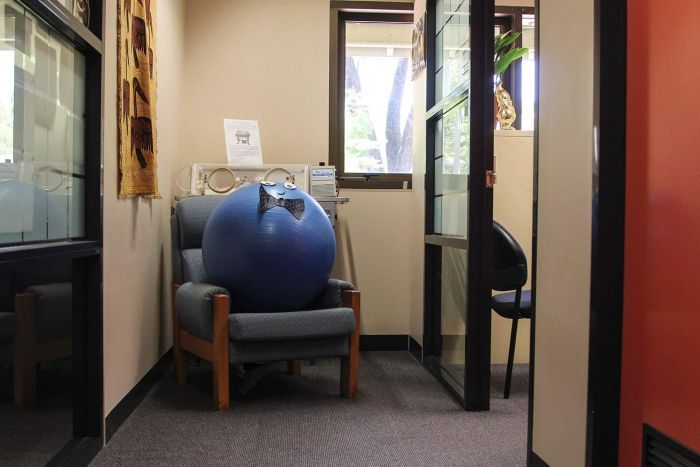 Photo:
Occasionally the museum's "pop up" displays get obscured by people who don't know the exhibit is there. (ABC Radio Darwin: Emilia Terzon)
Photo:
Occasionally the museum's "pop up" displays get obscured by people who don't know the exhibit is there. (ABC Radio Darwin: Emilia Terzon)
For Janie, the reason to keep going is still the same motivation of preserving the Territory's nursing history, with the collection recently deemed as valuable in a significance assessment due to this very reason.
"I came here in 1964 to work as a bush nurse in Batchelor," she said.
"It was a unique and unexpected experience having come from southern training school like most of us did. I think even today, people find working in what is a pretty typical modern hospital, they find a lot of surprises.
"The local Darwin and Territory culture can surprise. There's the unexpected. It's obvious this is a different part of Australia.
"And we need to keep that story alive because it's not the same story as Victorian nursing."
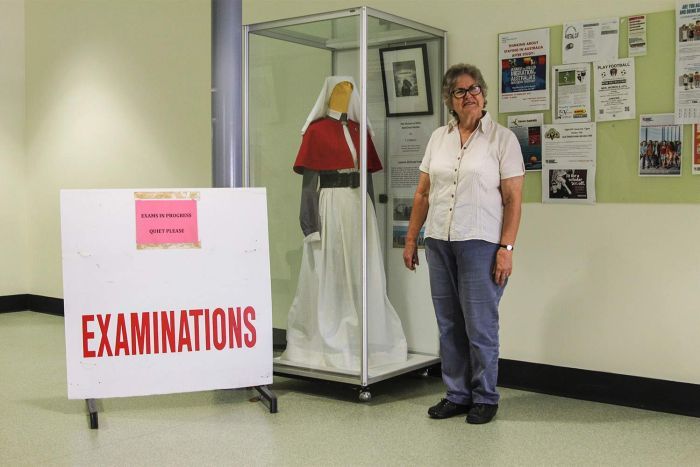 Photo:
Janie Mason outside an exhibit as part of Darwin's Nursing Museum. (ABC Radio Darwin: Emilia Terzon)
Photo:
Janie Mason outside an exhibit as part of Darwin's Nursing Museum. (ABC Radio Darwin: Emilia Terzon)
Topics: medical-history, doctors-and-medical-professionals, health, volunteers, library-museum-and-gallery, human-interest, darwin-0800


